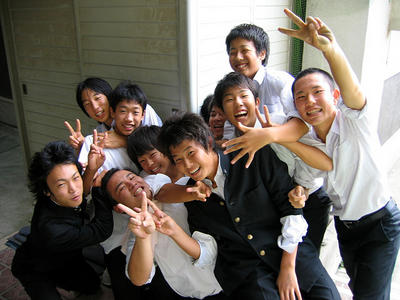Monday morning. I pop three Advil. Starting the school week is as tough for teachers as it is for students. And when my schedule reads “Kanokita,” I down another three by lunchtime. At cooperative schools, the week’s first lesson is spent trying to revive zonked out students, who even on a lively day barely register a pulse.
At Tokyo’s worst junior high school, however, the challenge is greater. The unrestrained freedom of the weekend hasn’t worn off. Screams befitting a haunted house echo down the hallways. Metallic clanging comes from an unknown source. Mondays are like managing a prison riot.
A pack of 8th grade girls roams the hallways like dingoes in the Outback. The din outside drowned out responses of students’ weekend activities. The girls pressed their faces against the window of the sliding classroom door. When that didn’t garner enough attention, they took turns crashing into the doors, hoping to incite commotion. When that failed, Seiko flung open the door, paced around the back of the room, and stripped off her gym shorts from underneath her uniform dress. I was in for a long week. How bad is the mischief? Well, at first I mistook two late-20 year-olds as extra gym teachers because of their affinity for warm-up work clothes. It turns out that these Adidas-clad “cowboys,” as I call them, function solely to patrol the halls and round up delinquents who have lost their way to class.
How bad is the mischief? Well, at first I mistook two late-20 year-olds as extra gym teachers because of their affinity for warm-up work clothes. It turns out that these Adidas-clad “cowboys,” as I call them, function solely to patrol the halls and round up delinquents who have lost their way to class.
The cowboys can’t catch ’em all. Discipline here is a revolving door. Teachers turn a blind eye. That was all I could do from a second floor window when I spotted two students fleeing the coop. One must have sensed my gaze because as he swung his leg over the top of the gate, he glanced up. Our eyes connected. A guilty grin crossed his face. I outstretched a hand in powerless protest. He completed the gymnastic descent, and took off down the road to catch up with his friend.
Desktops are a good barometer of a school’s discipline level. At Kanokita, they are covered with permanent black ink. Japlish graffiti artists sometimes outnumber English note takers. If students spent as much time completing handouts as on desk drawing, their proficiency might be marginally passable.
At Kanokita, the 7th graders are good, the 8th graders are bad, and the 8th grade girls are ugly. Behavior-wise, that is. Out of approximately 1,100 students at four schools, the two biggest delinquents are girls. Seiko’s brazen disregard for school rules intimidates even teachers.
Maki follows Seiko’s bad example with obedient disobedience. She is shorter but prettier than the ringleader, who at times attracts a few other otemba (naughty girls) to join her rebellion, which spurs the cowboys into action. If I were a scout, I’d offer Maki a modeling contract as soon as her grades improve. Even Taro, one of the cowboys, gives me the nod and grin when Maki passes.
While Maki is toothless without Seiko, unfortunately both are in the same English section. I was relieved but not surprised to see neither of them when I walked into class. I hoped they were terrorizing another floor or smoking off-property. Ten minutes later the sliding door rattled open, and in barged the twin terrors, carrying on a conversation that had nothing to do with the target English.
Maki plopped her knapsack on her desk, and used it as a pillow. Seiko proclaimed the window ledge as her throne, and peered out of rain-streaked windows. Wind pounded on the glass. Seiko answered nature’s call. Woooosh! English worksheets took flight, and mechanical pencils rolled off desks.
Seiko abandoned the ledge and walked around the classroom to inspect her territory – marked desktops. The wind fanned Mr. Hirogashi’s ire. Seiko remained cool, calm, and defiant. The Japanese English teacher barked. Seiko snickered. The exchange escalated. I didn’t need a translation of the unfolding brinkmanship. “Get out! GET OUT!” Seiko for once obeyed, probably wondering what took so long for the invitation. Maki grabbed her bag and followed.
Later that day, I went to the principal’s office. There, the girls would make amends, but Mr. Hirogashi remained skeptical: “They will pretend to apologize, and we will pretend to forgive them.” The twin terrors sat beside Mr. Kyobashi, the white-haired principal turned peacekeeper. I spoke first, striking a conciliatory tone: “I hope next time you can stay for the whole lesson and learn some English.” Maki smiled at the translation, but when Mr. Hirogashi spoke, Seiko looked away. She mumbled an apology to the wall.
Days later, the school counselor invited me to her office. “It’s nice to meet you,” I said. “You sure must be busy.” She wanted to chat about schools in New York that she had observed on a training program. “Do you know the South Bronx?” I answered with my eyes, and then laughed, “So you’ve seen worse.” She had visited a second chance school for juvenile delinquents that made Seiko seem like a teacher’s pet.
Tokyo is no SoBro, but the counselor picked out a similarity in that students “were not proud” of their schools. Without discipline there is no respect. And without respect there is no chance of learning. And in Tokyo there is no second chance.
Monday, October 17, 2005
D is for Delinquency
Subscribe to:
Post Comments (Atom)



1 comment:
do you really pop advil, or have you found some amazing eastern meds to ease your pains?
D is for Drugs!
(just kiddin'.)
Post a Comment